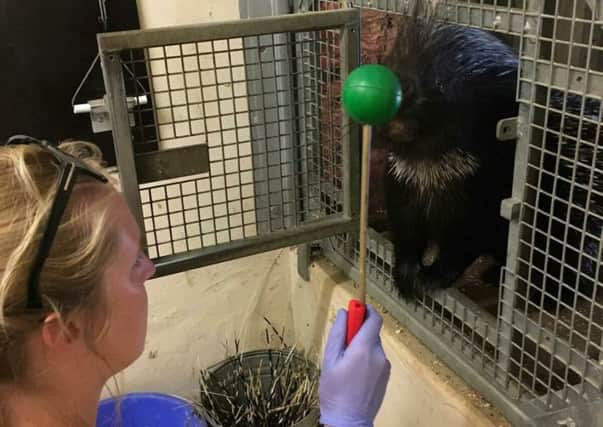View from the Zoo: Training regime benefits health and welfare of porcupines


Our two Cape porcupines, Grumpy who is male and is 10 yers old and Mrs Prickles who is eight have been going through a very special training regime over the past few weeks.
Mrs Prickles gained the name through her extremely sharp quills made up of hair which act as spikes which help to deter predators.
Advertisement
Hide AdAdvertisement
Hide AdPorcupines are nocturnal so you may notice them snoozing inside their house for most of the day but they do occasionally wander out in their outdoor enclosure. They live alongside the meerkats and have a diet predominantly of a wide variety of vegetables.
The training regime is called target training and involves a target stick for the porcupines to place their nose against. This is followed by the use of a clicker which tells the porcupine they have done the correct behaviour and will receive their favourite treat as a reward.
Grumpy loves parsnips whilst Mrs Prickles’ favourite is raw potatoes. They also receive a specialised pellet which is full of nutrition.
As target training progresses it allows the keepers to guide them onto scales or to crate train them so they are used to being in crates for transport. Grumpy is more confident and weighs around 15 kilograms. Surprisingly heavy for a rodent. The training benefits the animal’s health and welfare and can be done with all sorts of different species. Animals become more comfortable and confident around their keepers.
Advertisement
Hide AdAdvertisement
Hide AdCape porcupines originally come from Southern Africa and prefer territory that has rocky out-crops, caves, exposed tree roots and disused burrows. Unlike other rodents, a porcupine’s life span can range from between 15 to 20 years. In the wild their predators include leopards, lions, and hyenas. Their array of spines and quills act as a significant deterrent. If threatened they would remain perfectly still but if the threat continues they would become very aggressive, making grunting noises, stamping their feet and rattling their hollow quills. Porcupines can also raise up their quills making themselves appear larger and more dangerous.